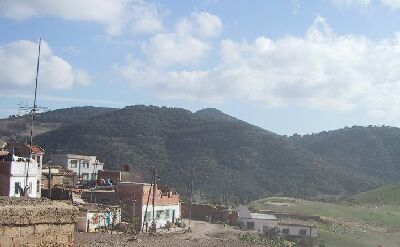
Marrakesh Express
Women Weavers OnLine
Ben Smim
Morocco is a relatively small country, about twice the size of California, and like California has many climates: beaches, mountains, forests, rich plains and deserts. What surprises me is that it has such rich and varied weaving traditions. I have one group of weavers on this site from N'kob, a village in the High Atlas Mountains south of Marrakesh. You will meet another group here, from Ben Smim, a village in the Middle Atlas Mountains about an hour south of Fes or Meknes and quite near Ifrane. Both groups are Berbers, but in the south they speak the Tashelhit or Shilha dialect, while in the Middle Atlas they speak Tamazight. Their weaving is also very different, as you can see by comparing rugs from the different areas. The High Atlas does mainly pile rugs, while the Middle Atlas is mostly flatweaves (though each do some of the other). Another distinguishing characteristic is that in the Middle Atlas they use many sequins, which give the rugs a "sparkle" in sunlight or lantern light, and the designs also vary.
This is the village of Ben Smim. You can see how it is set in the mountains. If you click on the photo you can see more detail, including the light post and TV antennas, so you know they have electricity. This is one of the few areas of Morocco with remaining forest cover. There is a cedar forest nearby, and pine and scrub oak also grow abundantly.
If you turn around, you see more of Ben Smim, including the freshly-sprouting grass after the fall rains, and some of the local animals, so you know this is an agricultural area. The sheep produce wool for the rugs. You can also see that some of the houses are made of stone, and some of brick. You can see both materials on the right, and everything more clearly, when you click to enlarge the photo.
As you go into the village, you get a better view of the construction. Many houses have mud and stone on the roof, to insulate them in this cold area. Snow falls in the winter, and many people heat with wood-burning stoves. While mud or adobe houses may look "primitive" to some, in fact they are much more comfortable than the modern concrete. They are warmer in the winter and cooler in the summer because of their insulating properties.
This is Habiba Lrhachi on the right, the rug project assistant in Ben Smim, with her older sister who is a weaver. Habiba has a BA in Geography, but has not been able to find a job that uses her training. She taught literacy classes to village women in the past and found it rewarding, but the funding stopped. She is eager to help her neighbors sell their weaving. She described how after the first pieces sold, she paid the women. She said "I knocked on the door and when they opened it I said "Here's your money." They were so happy! No one here knocks on the door and gives you money - they ask for money, like for the electric bill." She also said some of the women reinvested their profits in wool to make more pieces to sell. This is important: in a nearby village, women told me they no longer sell their weaving. They said the prices middlemen offer them are too low for all the work involved. In Ben Smim, selling things may be helping to keep the weaving tradition alive.
Another person who is assisting with this project is Brahim, one of the local grocers (his wife also weaves). Here you see him in his shop, really a general store, holding the scale we used to weigh the rugs. Since we need to know the weight to calculate the postage to mail the rugs, we needed a scale, and such an item is difficult to find in a village. He was very generous to lend his when we needed it.
This is how we used the scale. Brahim advised us to roll the rugs up tightly and balance them on an empty can, so that was also part of our equipment.
Once an order comes in for a piece, Habiba takes it into the nearby town of Ifrane, a Moroccan resort town with buildings that look like Swiss chalets. There these two gentlemen from the post office, Mr. Hicham Hachmi and Mr. Abdelkader Chakou, process the package so that it will arrive at its destination in good condition. Packages are sent airmail and insured, and usually arrive in the US in two to three weeks.